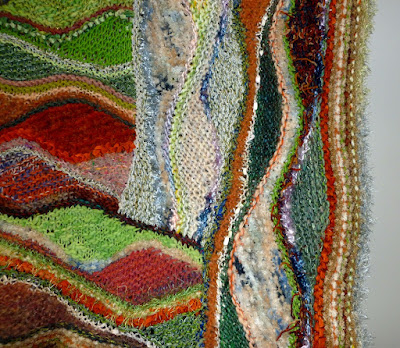But most of those yarns are made so each side is different, and that was going to take some thought. In the meantime, I looked through my stash and found this.
Using one of my magic balls of yarn, I picked up every other loop on one side with a size 11 needle, and then picked up the remaining loops on the other side with another size 11 needle, placing two markers at each end. Then I just continued knitting one entire round, and then purling the next so I had a garter effect, and continued in this fashion until it was wide enough.
At each end, I increased on either side of the markers on each knit round, which is what squared off the ends.
Here's one more look at the center. By picking up every other loop, it ended up looking like a bit of lace in the middle.
All in all, a success! And this made me brave.
So I went to JoAnn's (a craft and fabric store) looking for some lace to use the same way. I found this.
I took another magic ball, this one from all whites and beiges, and made another scarf the same way.
I rounded off the ends of this one instead of squaring them by adding 4 stitches roughly evenly spaced between the end markers on each knit round.
Here are some other looks, although note that I haven't blocked this one yet.
Another success.
I think of the yarn at JoAnn's as being on the cheap and less interesting side, so I was astonished at how beautiful much of it was--my, how yarn choices have grown! I bought these while I was there.
And these inspired me to return to my original idea, and begin in the center with the ruffle yarn. I solved the sides-not-matching issue by doubling it and then using the other yarn to crochet a join up the middle, before picking up and starting around and around the sides.
Here's the result.
I tried to match the ruffle yarn in the middle so that the same shade was on either side of the join. The middle was unexpectantly large, so I only had to knit a few rounds (using the rounded corners again) before casting off, pulling in some of the same ruffle yarn in each cast-off stitch.
It looks very glamorous in real life. Here are some closer pictures.
I'm very pleased with all the scarves, and they couldn't be easier to make. I'm going to have to try a few more variations.
Oh, and those glimpses of tabby tails? They belong to him.
The inspector.
























































